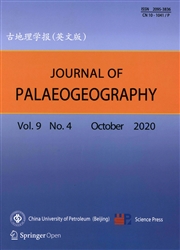Geologic-seismic models,prediction of shallow-water lacustrine delta sandbody and hydrocarbon potential in the Late Miocene,Huanghekou Sag,Bohai Bay Basin, northern China
作者:Hao Liu,Qing-Long Xia,Xin-Huai Zhou
摘要:The Huanghekou Sag is located at the southeast part of the Bohai Bay Basin, northern China. Large-scale shallow lake delta developed in the Neogene provided suitable geological conditions for the formation of a subtle oil-gas reservoir in this area. The key for analyzing sandstone reservoir and sedimentary facies is by using seismic attributes(amplitude) to establish the relationship between lithology combination and seismic attributes. The lower unit of Late Miocene Minghuazhen Formation at the BZ34 block in the Huanghekou Sag was subdivided into 10 parasequence sets(PSS). Thicker sandstones mainly occurred in PSS1 and PSS10, whereas thin sandstones are mostly observed within other parasequence sets. This study presents statistics and analyses of lithology, i.e., statistics of root-meansquare(RMS) amplitude and lithology of well locations in different parasequence sets of the study area,as well as 1-D forward seismic models of 7 types of lithology combinations, the establishment of a spatial distribution of 2-D sandbody, forward seismic models etc. Our study indicates that high amplitude peaks correspond to thicker sandbodies, while low amplitude indicates non-development of sandbodies(generally less than 2 m), and medium amplitude agrees well with large sets of mudstones interbedded with medium and thinner sandstones. Different sand-mudstone combinations genetically reflect a combination of multiple micro-facies, therefore, amplitude features can predict sandbodies as well as facies characteristics.
发文机构:School of Ocean Sciences Exploration & Exploitation Research Institute Exploration & Exploitation Research Institute
关键词:SHALLOW-WATERLACUSTRINEDELTAHigh-frequencysequenceRoot-mean-square(RMS)amplitudeGeological-geophysicalmodelSandstonedepictionHuanghekouSAGLateMIOCENE
分类号: P[天文地球]
- Genus Pronephrium Presl 1851 (Thelypteridaceae) in Romania
- Ancient rip current records and their implications: an example from the Cretaceous Ukra Member, Kutch, India
- New freshwater plesiosaurian materials from the Middle Jurassic Xintiangou Formation of the Sichuan Basin, southwestern China
- First steps in reconstructing Early Jurassic sea water temperatures in the Andean Basin of northern Chile based on stable isotope analyses of oyster and brachiopod shells
- A facies and palaeogeography-based approach for analysis of petroleum systems in United Arab Emirates
- The complexity of climate reconstructions using the coexistence approach on Qinghai-Tibetan Plateau
- The use of mineral interfaces in sand-sized volcanic rock fragments to infer mechanical durability
- Fruits of Scirpus (Cyperaceae) from the early Miocene of Weichang,Hebei Province, North China and their palaeoecological and palaeobiogeographical implications
- Words of the Editor-in-Chief——some ideas about the comments and discussions of hyperpycnal flows and hyperpycnites
- Summary of Editorial Committee Meeting (January 5, 2020) of Journal of Palaeogeography


